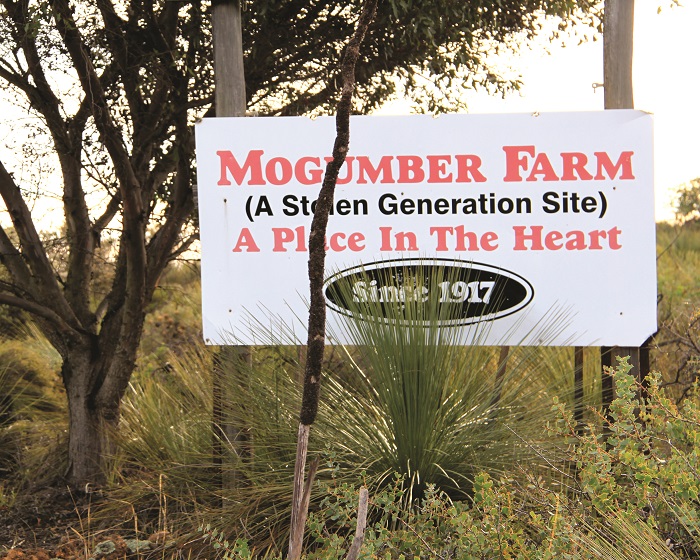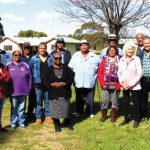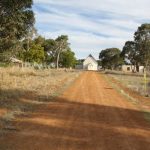It looked more like a concentration camp than a residential school for Aboriginal children.
Back at their dormitory the girls were trying to snuggle down in their cold, uninviting beds. Molly, Daisy and Gracie began to talk normally amongst themselves, not whispering, but speaking in their own relaxed manner.
“You girls can’t talk blackfulla language here, you know,” came the warning from the other side of the dorm. “You gotta forget it and talk English all the time.”
Text taken from Follow The Rabbit Proof Fence, by Nugi Garimara, 1996.
Follow The Rabbit Proof Fence tells the true story of three girls who escaped the Moore River Native Settlement in 1931.
This October, it’s been 100 years since the establishment of the Moore River Native Settlement, later named the Mogumber Mission. An event will be held to honour the anniversary, with mixed feelings about the place from those with a connection to it.
The Moore River Native Settlement, 135 kms north of Perth, was originally set-up by the State Government in 1918 under the control of AO Neville, the Chief Protector of Aborigines in WA at the time. It was to be a farming camp for Aboriginal people, but the land was unsuitable for crops. Over the next few years it became a site housing Indigenous Australians – mostly children, whom we now refer to as part of the Stolen Generations.
In 1951, the site was handed over to the Methodist Church of Australasia and was renamed the Mogumber Mission. It eventually closed in 1974, and the land was given to the Aboriginal Lands Trust.
Stephanie Mippy is one of the organisers of the two-day anniversary event at the site, which will encourage people to return and remember the history of her relatives. Her grandparents grew up there, and while she didn’t experience the place first hand, she heard many stories of the harshness of the camp.
“They used to have these dresses like a potato sack – a coarse dress that they used to wear. They had underwear of the same fabric,” Stephanie said. “They used to dress the children up when they had dignitaries coming there, but in the dorms it was pretty sad, you’d hear kids crying.
“Nan said that especially if there was a new kid, they would be sobbing. They’d been taken away from their parents and didn’t know what was going on. They used to put their beds together, so they could sleep next to each other,” she said.
“My Nan used to always try to run away from there because the discipline was very strict. Every time she ran away, she got caught. Her Dad was a tracker, so he was one of the ones that quite often found her,”she said.
Stephanie said if children tried to run off to gather food, or were caught misbehaving, they were punished by being locked in the ‘boob’, a tin shed with space under the door to pass through food.
“Nan used to say once she was in there for three days, could be a week. Depends on whoever was telling them off at the time,” Stephanie said.
Stephanie also recalled reading a letter in the Battye Library from her Grandfather to AO Neville requesting to visit his mother for her birthday. A response from Neville said she could wait at the fence and he would be able to go and greet her, but on the day he was not allowed.
“The next letter was ‘why did you make me wait all day to see my Neddy.’ They didn’t bring my grandfather to see her,” Stephanie said.
Not all memories were bad however, as many saw their childhood as being just that – their childhood.
Ruby Ryder was born on the Moore River Native Settlement and lived in a cottage as her Dad worked as a policeman. She has fond memories of playing as a child, sliding on a tin sheet down the hills and tending to pigs on the site. But, she also sees the hurt in people caused by being taken from their parents.
“We’re a people where happiness is not hard to find if you want it,” she said. “But what I’ve seen growing up is that there’s a lot of misery in our Aboriginal people.”
Margaret Mippy was also born on the Moore River Native Settlement, and is a Stolen Generations survivor. Once her parents were married they were allowed to leave the settlement, but they weren’t allowed to take her with them, so were separated.
“We grew up there with the other kids who were taken away,” she said. “We all grew up together without our mums and dads; people from the north and south, we all grew up together.
“Sometimes we ran away, but they ended up catching us. They’d round us all up like sheep.
“It was our world and that was it. We were told what to do and had our rules and that’s how we were brought up.
“Sometimes I feel sad, but sometimes it’s happy because you meet other people who were taken away and we grew up with them, and we talk. We’ve all got the same story.”
Growing up separated from family had its effects right into adulthood, as Margaret recalled burying a friend at the Mogumber cemetery after the site had closed. He had spent his life searching for his mother, who Margaret ran into some time after he had passed.
“I was working and I met his mum, I just sobbed and sobbed,” she said. “I told her what happened to her son and that he was buried in Mogumber. She was glad that I told her the story.”
While government policies towards Aboriginal people at the time of the Moore River Native Settlement were awful, Stephanie said that there were some good people around who did care about what was going on. She told the story of a non-Indigenous woman who used to hide Indigenous children in her house, so that they wouldn’t get taken away.
“Police would go there and would ask ‘have you got any kids here?’ And she said ‘no there’s no kids here’ even though she had them hidden in the house,” Stephanie said.
“There were some people that did protect the kids and their families; which is beautiful, the faith in humanity.”
Rev Dennis Doust, Uniting Church WA minister, spent some of his formative years at Mogumber Mission, working with the Methodist Church in his 20s. He also remembers both the sadness and grace that was evident at the site.
“There were multiple decades of the Moore River Settlement representing imperialistic oppression and destruction of Aboriginal people, relationships, family and society,” he said. “There has been much regret that the Government’s and subsequently, the church’s oversight, once it became the Mogumber Methodist Mission, created great pain for many Aboriginal people that is still felt today.
“As representatives of the Uniting Church, unlike the Government model, our involvement with the Aboriginal people at Mogumber came from a Christ-centred relational attitude – but, as an agent of Government policy, we of the Methodist/Uniting Church didn’t always get it right.
“Despite our good intentions, the impact of losing connection to culture, country, language and family is still having repercussions. There are wounds that need healing. Yet still, I remember the light of Christ being present and shining in the midst of pain.”
In 1996, the Uniting Church in Australia formally apologised to Australia’s Stolen Generations for its part in the process.
“The church thought it was acting in a loving way by providing [Aboriginal children] with homes, but was blind to the racist assumptions that underlay the policy and practice,” the apology states.
Since the site closed in 1974, it has not been looked after, with many of the buildings run-down or non-existent. Stephanie, Ruby and Margaret all agree that restoring the site would be a great way to honour those who lived there.
“There’s hardly anything there,” Margaret said. “There’s no hospital where I was born, that’s all knocked down and gone. The only thing there The centenary of the Moore River Native Settlement will be held from is the church; it’s got no church bell – someone stole it.”
Margaret said she wants it to be restored as a historical site, “so that we can go there and I can show my kids and they can show their kids.
“Keep it going, build it up again, so the young generations can see what we went through,” she said.
Stephanie said that restoring the site would be a step towards healing for WA’s Indigenous people, and they are currently seeking funding to bring this to reality.
“I don’t want it to be forgotten,” Stephanie said. “Yeah, there were atrocities that happened there, but we need to pay homage to those that lived there, died there and grew up there.
“They’re such strong people to endure all that, to be taken away from your parents and put away when you can’t speak English.
“I would love for people to remember that and to remember whilst they endured a lot of heartache and pain, the ones that were able to survive it, they’re the true warriors. I can’t sing their praises enough.
“Sadly, a lot of children died on the site. I was told what happened there is genocide. But there’s nothing we can do to change that, so let’s go there and respect and remember all those that were there.
“There’s a lot of displaced people in society because of this,” Stephanie continued. “There’s a lot of healing to be done and I’d love to see this as a stepping stone in that process. Let’s see this as a stepping stone and start healing.”
The centenary event happening in October will provide some space for this healing to continue. Stephanie is expecting people from all over Australia to attend what will hopefully be like a big ‘family reunion’. There’ll be a healing ceremony, traditional dancing, a church service, a historical display, site tours, entertainment, food and most importantly, lots of storytelling. Aboriginal and non-Aboriginal people alike are invited to come and share in this historical event of remembering our shared history.
Inspired?
The centenary of the Moore River Native Settlement will be held from Friday 26 to Saturday 27 October, at Mogumber. For more information or to find out how you can help, call Stephanie on 0488 687 551.
For more information and photos from the Moore River Native Settlement visit dlgsc.wa.gov.au/achwa/Pages/Moore-River.aspx
Heather Dowling




